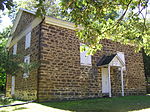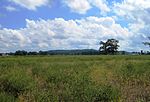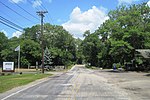Arney's Mount Friends Meetinghouse and Burial Ground
18th-century Quaker meeting housesCemeteries in Burlington County, New JerseyChurches completed in 1775Churches in Burlington County, New JerseyChurches on the National Register of Historic Places in New Jersey ... and 5 more
Historic American Buildings Survey in New JerseyNational Register of Historic Places in Burlington County, New JerseyNew Jersey Register of Historic PlacesQuaker meeting houses in New JerseySpringfield Township, Burlington County, New Jersey

Arney's Mount Friends Meetinghouse and Burial Ground is a historic Quaker meeting house located at the intersection of Mount Holly-Juliustown and Pemberton-Arney's Mount Roads in Arney's Mount, Burlington County, New Jersey, United States.
Excerpt from the Wikipedia article Arney's Mount Friends Meetinghouse and Burial Ground (License: CC BY-SA 3.0, Authors, Images).Arney's Mount Friends Meetinghouse and Burial Ground
Arney's Mount Road,
Geographical coordinates (GPS) Address Nearby Places Show on map
Geographical coordinates (GPS)
| Latitude | Longitude |
|---|---|
| N 40.009166666667 ° | E -74.697222222222 ° |
Address
Arney's Mount Road 297
08068
New Jersey, United States
Open on Google Maps







